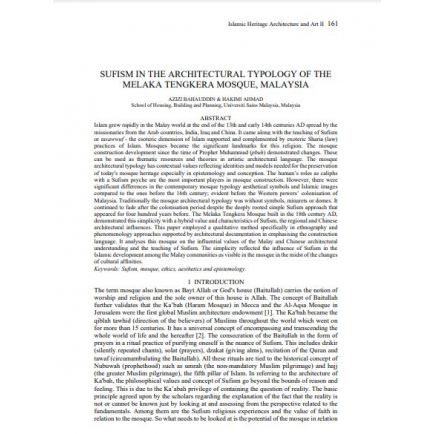
SUFISM IN THE ARCHITECTURAL TYPOLOGY OF THE MELAKA TENGKERA MOSQUE, MALAYSIA
تاريخ الاضافة
22/06/2022
نوع المحتوى
Documentary
Category
Researches
الرابط للمحتوى
Subject Area
Mosques
الكاتب
AZIZI BAHAUDDIN & HAKIMI AHMAD
الناشر
Islamic Heritage Architecture and Art II
Year of Publication
2018
الوصف
Islam grew rapidly in the Malay world at the end of the 13th and early 14th centuries AD spread by the
missionaries from the Arab countries, India, Iraq and China. It came along with the teaching of Sufism
or tasawwuf - the esoteric dimension of Islam supported and complemented by exoteric Sharia (law)
practices of Islam. Mosques became the significant landmarks for this religion. The mosque
construction development since the time of Prophet Muhammad (pbuh) demonstrated changes. These
can be used as thematic resources and theories in artistic architectural language. The mosque
architectural typology has contextual values reflecting identities and models needed for the preservation
of today's mosque heritage especially in epistemology and conception. The human’s roles as caliphs
with a Sufism psyche are the most important players in mosque construction. However, there were
significant differences in the contemporary mosque typology aesthetical symbols and Islamic images
compared to the ones before the 16th century; evident before the Western powers’ colonisation of
Malaysia. Traditionally the mosque architectural typology was without symbols, minarets or domes. It
continued to fade after the colonisation period despite the deeply rooted simple Sufism approach that
appeared for four hundred years before. The Melaka Tengkera Mosque built in the 18th century AD,
demonstrated this simplicity with a hybrid value and characteristics of Sufism, the regional and Chinese
architectural influences. This paper employed a qualitative method specifically in ethnography and
phenomenology approaches supported by architectural documentation in emphasising the construction
language. It analyses this mosque on the influential values of the Malay and Chinese architectural
understanding and the teaching of Sufism. The simplicity reflected the influence of Sufism in the
Islamic development among the Malay communities as visible in the mosque in the midst of the changes
of cultural affinities





